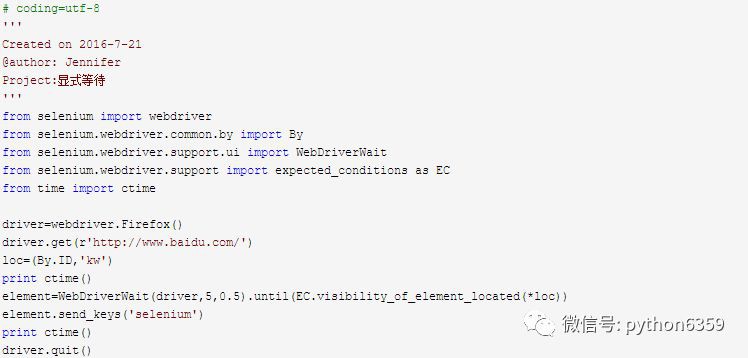
此篇文章整理新手編寫程式碼常見的一些錯誤,有些錯誤是粗心的錯誤,但對於新手而已,會折騰很長時間才搞定,所以在此總結下我遇到的一些問題。希望幫助到剛入門的朋友們。
NameError變數名錯誤
報錯:
>>> print a
Traceback (most recent call last):
File ““, line 1, in
NameError: name ‘a’ is not defined
解決方案:
先要給a賦值。才能使用它。在實際編寫程式碼過程中,報NameError錯誤時,檢視該變數是否賦值,或者是否有大小寫不一致錯誤,或者說不小心將變數名寫錯了。
註:在Python中,無需顯示變數宣告陳述句,變數在第一次被賦值時自動宣告。
>>> a=1
>>> print a
1
IndentationError程式碼縮排錯誤
程式碼:
a=1b=2
if a<b:
print a
報錯:
IndentationError: expected an indented block
原因:
縮排有誤,python的縮排非常嚴格,行首多個空格,少個空格都會報錯。這是新手常犯的一個錯誤,由於不熟悉python編碼規則。像def,class,if,for,while等程式碼塊都需要縮排。
縮排為四個空格寬度,需要說明一點,不同的文字編輯器中製表符(tab鍵)代表的空格寬度不一,如果程式碼需要跨平臺或跨編輯器讀寫,建議不要使用製表符。
解決方案:
a=1b=2
if a<b:
print a
AttributeError物件屬性錯誤
報錯:
>>> import sys
>>> sys.Path
Traceback (most recent call last):
File ““, line 1, in
AttributeError: ‘module’ object has no attribute ‘Path’
原因:
sys模組沒有Path屬性。
解決方案:
python對大小寫敏感,Path和path代表不同的變數。將Path改為path即可。
>>> sys.path
[”, ‘/usr/lib/python2.6/site-packages’]
python知識拓展:
使用dir函式檢視某個模組的屬性
>>> dir(sys)
[‘__displayhook__’, ‘__doc__’, ‘__egginsert’, ‘__excepthook__’, ‘__name__’, ‘__package__’, ‘__plen’, ‘__stderr__’, ‘__stdin__’, ‘__stdout__’, ‘_clear_type_cache’, ‘_current_frames’, ‘_getframe’, ‘api_version’, ‘argv’, ‘builtin_module_names’, ‘byteorder’, ‘call_tracing’, ‘callstats’, ‘copyright’, ‘displayhook’, ‘dont_write_bytecode’, ‘exc_clear’, ‘exc_info’, ‘exc_type’, ‘excepthook’, ‘exec_prefix’, ‘executable’, ‘exit’, ‘flags’, ‘float_info’, ‘getcheckinterval’, ‘getdefaultencoding’, ‘getdlopenflags’, ‘getfilesystemencoding’, ‘getprofile’, ‘getrecursionlimit’, ‘getrefcount’, ‘getsizeof’, ‘gettrace’, ‘hexversion’, ‘maxint’, ‘maxsize’, ‘maxunicode’, ‘meta_path’, ‘modules’, ‘path‘, ‘path_hooks’, ‘path_importer_cache’, ‘platform’, ‘prefix’, ‘ps1’, ‘ps2’, ‘py3kwarning’, ‘setcheckinterval’, ‘setdlopenflags’, ‘setprofile’, ‘setrecursionlimit’, ‘settrace’, ‘stderr’, ‘stdin’, ‘stdout’, ‘subversion’, ‘version’, ‘version_info’, ‘warnoptions’]
TypeError型別錯誤
1
入參型別錯誤
程式碼:
t=('a','b','c')
for i in range(t):
print a[i]
報錯:
TypeError: range() integer end argument expected, got tuple.
原因:
range()函式期望的入參是整型(integer),但卻給的入參為元組(tuple)
解決方案:
將入參元組t改為元組個數整型len(t)
將range(t)改為range(len(t))
2
入參個數錯誤
關於元組作為入參
程式碼:

報錯:
Traceback (most recent call last):
File “D:\system files\workspace\selenium\autotestcombat\test_4_7_1_webdriverwait.py”, line 18, in
element=WebDriverWait(driver,5,0.5).until(EC.visibility_of_element_located(*loc))
TypeError: __init__() takes exactly 2 arguments (3 given)
原因:
類的函式__init__()需要兩個引數,但實際上給了三個。
EC.visibility_of_element_located類的入參應該是兩個入參: self和元組。但卻給了三個引數 self和*loc中的兩個元素作為入參。
解決方案:
這裡要將EC.visibility_of_element_located(*loc)改為EC.visibility_of_element_located(loc),入參為元組,而不是元組裡邊的兩個值。
python知識拓展:
關於入參*的用法
以元組作為函式入參,如果元組前加*號,說明傳遞的入參為元組中的各個元素。如果元組前沒有加*號,說明傳遞的入參為元組本身。
舉例說明:
loc =(By.NAME,’email’)
element1=WebDriverWait(driver,5,0.5).until(EC.visibility_of_element_located(loc)) #只要一個引數(不考慮self情況下),元組loc,即:(By.NAME,’email’)。 直接傳loc。
element2=driver.find_element(*loc)#需要兩個引數,元組loc的元素,即:By.NAME,’email’。直接傳*loc
3
其他
報錯:
>>> import os
>>> os.listdir()
Traceback (most recent call last):
File ““, line 1, in
TypeError: listdir() takes exactly 1 argument (0 given)
原因:
listdir()函式需要一個入參,但是隻給了0個入參。
解決方案:
加一個入參
>>> os.listdir(‘/home/autotest’)
[‘hello.py’, ’email126pro’]
python知識拓展:
如何檢視某個函式的使用,可以使用help檢視。
>>> help(os.listdir)
Help on built-in function listdir in module posix:listdir(…)
listdir(path) -> list_of_stringsReturn a list containing the names of the entries in the directory.
path: path of directory to list
說明:os.listdir()函式需要一個path路徑入參,函式結果傳回值是由字串組成的串列。
4
非函式卻以函式來呼叫
報錯:
>>> t=(‘a’,’b’,’c’)
>>> t()
Traceback (most recent call last):
File ““, line 1, in
TypeError: ‘tuple’ object is not callable
原因:
t為元組,元組不能被呼叫,不能加()。初學者編寫程式碼時,偶爾粗心會將變數當做方法來呼叫(不小心加了括號)。所以要認真檢查下是否變數加了括號,或者方法漏加了括號。
解決方案:
將括號去除。
>>> t
(‘a’, ‘b’, ‘c’)
IOError輸入輸出錯誤
檔案不存在報錯
報錯:
>>> f=open(“Hello.py”)
Traceback (most recent call last):
File ““, line 1, in
IOError: [Errno 2] No such file or directory: ‘Hello.py’
原因:
open()函式沒有指明mode,預設為只讀方式,如果該目錄下沒有Hello.py的檔案,則會報錯,可檢視是否拼寫有錯誤,或者是否大小寫錯誤,或者根本不存在這個檔案。
解決方案:
該目錄下有hello.py檔案,開啟該檔案即可。
>>> f=open(“hello.py”)
python知識拓展:
如何檢視python直譯器當前路徑:
>>> import os
>>> os.getcwd()
‘/home/autotest’
檢視python直譯器當前路徑下有哪些檔案:
>>> os.listdir(‘/home/autotest’)
[‘hello.py‘, ’email126pro’]
因檔案許可權問題報錯
報錯:
>>> f=open(“hello.py”)
>>> f.write(“test”)
Traceback (most recent call last):
File ““, line 1, in
IOError: File not open for writing
原因:
open(“hello.py”)如果入參沒有加讀寫樣式引數mode,說明預設開啟檔案的方式為只讀方式,而此時又要寫入字元,所以許可權受限,才會報錯。
解決方案:
更改樣式
>>> f=open(“hello.py”,’w+’)
>>> f.write(“test”)
KeyError字典鍵值錯誤
報錯:
常見報錯有,測試一介面,介面傳回資料一般是json格式,而測試該介面校驗某個值是否正確,如果key拼寫錯了,就會報KeyError。簡單舉例如下:
>>> d={‘a’:1,’b’:2,’c’:3}
>>> print d[‘a’]
1
>>> print d[‘f’]
Traceback (most recent call last):
File ““, line 1, in
KeyError: ‘f’
解決方案:
訪問d中有的鍵值,如a,b或c。
推薦閱讀
作者:煜妃
源自:https://www.cnblogs.com/yufeihlf/p/6068589.html#test0
宣告:文章著作權歸作者所有,如有侵權,請聯絡小編刪除
 知識星球
知識星球
